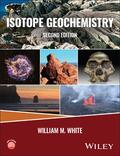Isotope Geochemistry

2. Auflage März 2023
720 Seiten, Softcover
Lehrbuch
ISOTOPE GEOCHEMISTRY
Provides a thorough and up-to-date overview of radiogenic and stable isotope geochemistry
Now in its second edition, Isotope Geochemistry presents a comprehensive introduction to radiogenic and stable isotope geochemistry. The first five chapters cover fundamentals including the physics of nuclei, radioactive decay, nucleosynthesis, geochronology, and the theory of stable isotope fractionation. The next chapter focuses on the isotope geochemistry of meteorites and their constraints on the formation of the solar system and the Earth. The subsequent three chapters cover radiogenic and stable isotope geochemistry evolution of the Earth's mantle and crust. Three more chapters are devoted to the Earth's surface, the exogene, including the hydrologic system, the biosphere, and climate. A new chapter in this edition focuses on the use of isotopes in paleontology and archeology. The final chapter is devoted to the isotope geochemistry of the noble gases.
Illustrated in full color throughout, Isotope Geochemistry is intended primarily as a textbook for advanced undergraduate and graduate students. It is also intended as a reference for earth science professionals, reflecting the impact that isotope geochemistry has on virtually every aspect of the earth sciences, from climate change and geomorphology to geodynamics.
2: Decay Systems and Geochronology I 2.1 Basics of Radioactive Isotope Geochemistry 2.2 Fundamentals of Geochronology 2.3 The K-Ar-Ca system 2.4 The Rb-Sr System 2.5 Rare Earth Decay Systems 2.6 The Re-Os-Pt System
3: Decay Systems and Geochronology II: U and Th 3.1 Introduction 3.2 Pb-Pb Ages and Isochrons 3.3 Zircon Dating 3.4 U-Decay Series Dating
4: Geochronology III: Other Dating Methods 4.1 Introduction 4.2 Cosmogenic Nuclides 4.3 Thermochronology
5: Fractionation of isotopes 5.1 Introduction 5.2 Notation, definitions, and standards 5.3 Theory of Equilibrium isotopic fractionations 5.4 Kinetic fractionation 5.5 Mass dependent versus mass dependent fractionation
6: Isotope Cosmochemistry 6.1 Introduction 6.2 Star Birth 6.3 Meteorites 6.4 Cosmochronology 6.5 Stardust 6.6 Isotopic variations in bulk meteorites 6.7 Cosmic ray exposure ages of meteorites
7: Isotope Geochemistry of the Mantle 7.1 Introduction 7.2 Composition of the Earth's Mantle 7.3 Radiogenic isotopes in oceanic basalts 7.4 Inferences on mantle structure and evolution 7.5 The Subcontinental Lithosphere 7.6 U-Series Isotopes and Melt Generation
8: Isotope geochemistry of the continental crust 8.1 Introduction 8.2 Mechanisms of crustal growth 8.3 The earliest continental crust 8.4 The continental crust through time 8.5 Isotopic composition of the continental crust 8.6 Subduction Zones
9: Stable Isotopes in the solid Earth 9.1 Introduction 9.2 Equilibrium Fractionations Among Minerals 9.3 Geothermometry 9.4 Stable Isotope Composition of the Mantle 9.5 Oxygen Isotopes in Hydrothermal Systems 9.6 Sulfur Isotopes in magmatic and hydrothermal systems 9.7 Copper isotopes in ore deposits
10: Light Stable Isotopes in the exogene 10.1 Introduction 10.2 The hydrologic system 10.3 isotope ratios in the biosphere 10.4 isotope ratios in the atmosphere
11: Non-traditional stable and radiogenic isotopes in the exogene 11.1 Introduction 11.2 Radiogenic isotopes in the modern ocean 11.3 Stable isotope ratios of conservative elements 11.4 Stable isotope ratios of nutrient elements 11.5 Stable isotope ratios of transition metals
12: Paleoclimate, paleoceanography, and atmospheric history 12.1 Introduction 12.2 The Pleistocene Climate Record in Deep Sea Sediments 12.3 Isotopes in paleoceanography 12.4 Climate in the Cenozoic 12.5 Carbon isotopes, atmospheric carbon dioxide, and climate 12.6 Tracing the evolution of atmospheric oxygen
13: Life, Paleoecology, and Human History 13.1 Introduction 13.2 Isotopes in evolution 13.3 Isotopes and diet: you are what you eat 13.4 Paleoecology of grasslands 13.5 Paleoecology of the Pleistocene Tundra Steppe 13.6.1 Domestication of maize 13.7 The metallurgical revolution
14: Noble Gas Isotope Geochemistry 14.1 Introduction 14.1.1 Noble Gas Chemistry 14.2 Noble Gases in the Solar System 14.3 Helium 14.4 Neon 14.5 Argon 14.6 Krypton 14.7 Xenon 14.8 Implications of Noble Gas Isotope Ratios for the Origin and Evolution of the Earth 14.9 Noble gas constraints on formation and evolution of the Earth


